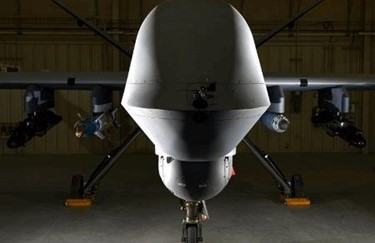Reaper/Predator UAV Performs In-Flight, Multiple-Spot Beam Switching On Intelsat EpicNG Satellite
By Jof Enriquez,
Follow me on Twitter @jofenriq

Unmanned aerial vehicles (UAVs) used by the United States Air Force have shown the capability to switch between multiple spot beams on the Intelsat EpicNG high-throughput satellite network.
In August, a Block 5 Predator B/MQ-9 Reaper, made by General Atomics, took off from a test facility near the Grand Forks Air Force Base in North Dakota. It successfully completed a 1,075 nautical mile trip to demonstrate the UAV's newly developed ability to travel long distances across multiple spot beams without losing contact, reports Space News.
“We’d been endeavoring for quite some time to get an opportunity to demonstrate the capability of the unmanned aircraft to switch between beams on one of the new Epic satellites,” Intelsat General Corp. President Skot Butler told Space News. “We made sure it would fly far enough that it would have to switch beams multiple times.”
Intelsat General and General Atomics secured a certificate of authorization from the Federal Aviation Administration (FAA) to conduct the test on the MQ-9 UAV without the need for a “chase aircraft,” according to Executive Biz.
Satellite operators have been showing how multiple spot beam design in high-throughput satellites could increase the effectiveness of UAVs in collecting data and images during critical military operations. They claim these satellites are capable of delivering bigger amounts of data – including live, real-time, high-definition video streaming – much faster than traditional satellites with legacy beam designs.
Intelsat’s EpicNG network of five on-orbit satellites "substantially increase the satellite’s throughput, allows for the use of much smaller antennas, higher performance from existing antennas, and enhances the security on the satellite over traditional wide beam satellites," according to a news release from its subsidiary Intelsat General, who conducted the demonstration before U.S. military officials.
Signals in spot beams are more difficult to jam, and interference can be worked around more easily, Butler told Space News. When either intentional jamming or accidental interference is encountered, "the satellite’s digital payload can easily disconnect the uplink from the downlink and assign new frequencies and a new link to the UAV to reestablish the connection," said Butler.
Since almost all UAVs operated by the U.S. Air Force use commercial Ku-band, switching over to high-throughput Ku-band makes more sense. It also costs less than transitioning to Ka-band frequencies, added Butler.
However, the U.S. government-owned Wideband Global SATCOM constellation uses the military Ka-band, and other satellite providers — most notably Inmarsat and SES Networks — also use Ka-band frequencies, according to Space News. Inmarsat says Ka-band allows seamless switching between adjacent commercial and military bands. SES claims that its O3B satellite can increase an MQ-9 Reaper's data transmission speed from the usual 5-10 megabits per second over Ku-band frequencies, to about 30 megabits per second over Ka-band.
